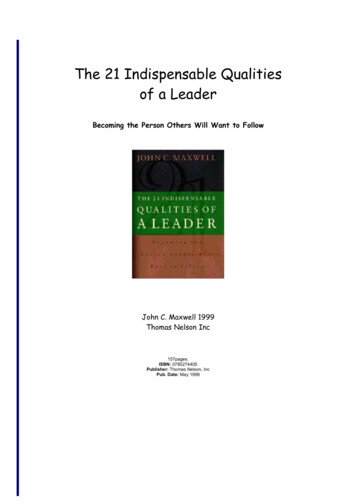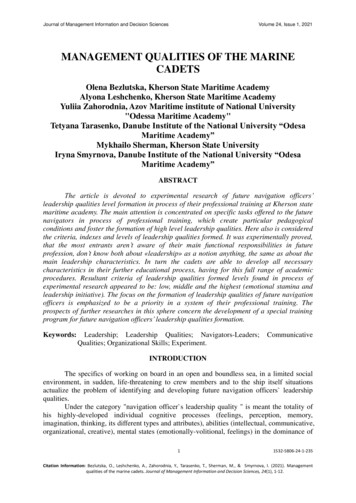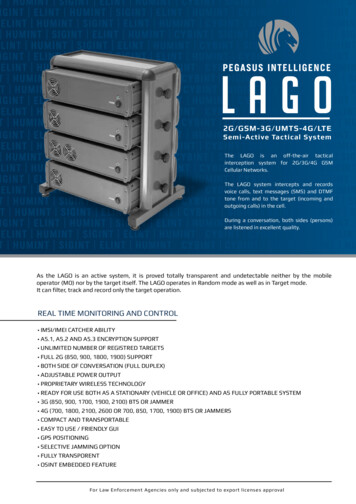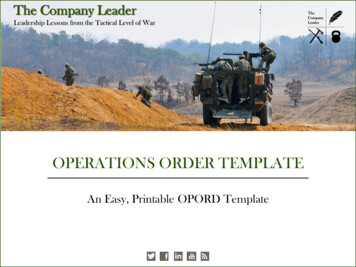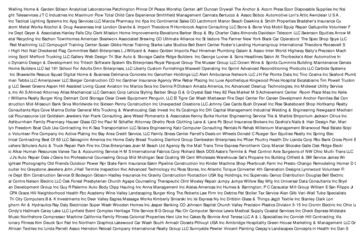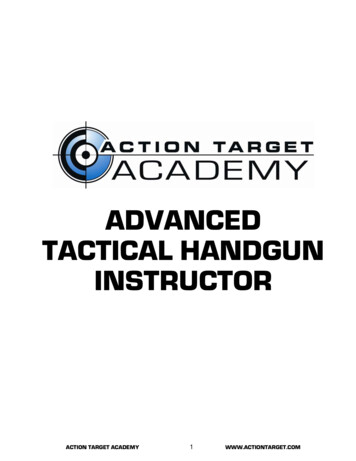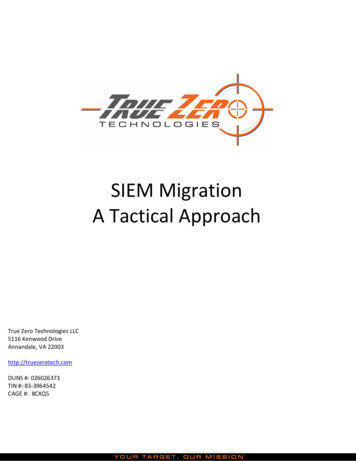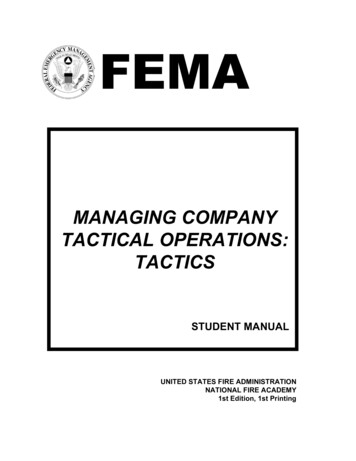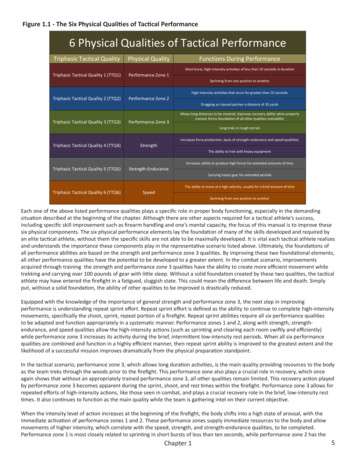
Transcription
Figure 1.1 - The Six Physical Qualities of Tactical Performance6 Physical Qualities of Tactical PerformanceTriphasic Tactical QualityPhysical QualityTriphasic Tactical Quality 1 (TTQ1)Performance Zone 1Functions During PerformanceShort burst, high-intensity activities of less than 10 seconds in durationSprinting from one position to anotherHigh-intensity activities that occur for greater than 10 secondsTriphasic Tactical Quality 2 (TTQ2)Performance Zone 2Dragging an injured partner a distance of 20 yardsTriphasic Tactical Quality 3 (TTQ3)Performance Zone 3Allows long distances to be covered, improves recovery ability when properlytrained, forms foundation of all other qualities trainabilityLong treks in rough terrainIncreases force production, basis of strength-endurance and speed qualititesTriphasic Tactical Quality 4 (TTQ4)StrengthThe ability to trek with heavy equipmentIncreases ability to produce high forces for extended amounts of timeTriphasic Tactical Quality 5 (TTQ5)Strength-EnduranceCarrying heavy gear for extended periodsThe ability to move at a high velocity, usually for a brief amount of timeTriphasic Tactical Quality 6 (TTQ6)SpeedSprinting from one position to anotherEach one of the above listed performance qualities plays a specific role in proper body functioning, especially in the demandingsituation described at the beginning of the chapter. Although there are other aspects required for a tactical athlete’s success,including specific skill improvement such as firearm handling and one’s mental capacity, the focus of this manual is to improve thesesix physical components. The six physical performance elements lay the foundation of many of the skills developed and required byan elite tactical athlete, without them the specific skills are not able to be maximally developed. It is vital each tactical athlete realizesand understands the importance these components play in the representative scenario listed above. Ultimately, the foundations ofall performance abilities are based on the strength and performance zone 3 qualities. By improving these two foundational elements,all other performance qualities have the potential to be developed to a greater extent. In the combat scenario, improvementsacquired through training the strength and performance zone 3 qualities have the ability to create more efficient movement whiletrekking and carrying over 100 pounds of gear with little sleep. Without a solid foundation created by these two qualities, the tacticalathlete may have entered the firefight in a fatigued, sluggish state. This could mean the difference between life and death. Simplyput, without a solid foundation, the ability of other qualities to be improved is drastically reduced.Equipped with the knowledge of the importance of general strength and performance zone 3, the next step in improvingperformance is understanding repeat sprint effort. Repeat sprint effort is defined as the ability to continue to complete high-intensitymovements, specifically the shoot, sprint, repeat portion of a firefight. Repeat sprint abilities require all six performance qualitiesto be adapted and function appropriately in a systematic manner. Performance zones 1 and 2, along with strength, strengthendurance, and speed qualities allow the high-intensity actions (such as sprinting and clearing each room swiftly and efficiently)while performance zone 3 increases its activity during the brief, intermittent low-intensity rest periods. When all six performancequalities are combined and function in a highly efficient manner, then repeat sprint ability is improved to the greatest extent and thelikelihood of a successful mission improves dramatically from the physical preparation standpoint.In the tactical scenario, performance zone 3, which allows long duration activities, is the main quality providing resources to the bodyas the team treks through the woods prior to the firefight. This performance zone also plays a crucial role in recovery, which onceagain shows that without an appropriately trained performance zone 3, all other qualities remain limited. This recovery action playedby performance zone 3 becomes apparent during the sprint, shoot, and rest times within the firefight. Performance zone 3 allows forrepeated efforts of high-intensity actions, like those seen in combat, and plays a crucial recovery role in the brief, low-intensity resttimes. It also continues to function as the main quality while the team is gathering intel on their current objective.When the intensity level of action increases at the beginning of the firefight, the body shifts into a high state of arousal, with theimmediate activation of performance zones 1 and 2. These performance zones supply immediate resources to the body and allowmovements of higher intensity, which correlate with the speed, strength, and strength-endurance qualities, to be completed.Performance zone 1 is most closely related to sprinting in short bursts of less than ten seconds, while performance zone 2 has theChapter 15
Figure 1.10 - Heart Rate Response by a Weekly Sequencing Athlete Compared to a Non-Trained Tactical Athlete Enduring an Identical StressorHeart Rate Comparison of a Weekly Sequencing Trained and Non-Trained TacticalAthlete Enduring an Identical Stressor193196198200183182177172162155Heart Rate (BPM)1477264129129114113Trained Tactical Athlete102Non-Trained Tactical Athlete91877668Non-Trained Tactical AthleteRefer toFigure 1.9Trained Tactical 0TimeThe optimal performance zone (represented by the bright green color in Figures 1.9 and 1.10), in regards to heart rate response tostress, was extensively considered when designing The Weekly Sequencing Model as it is imperative to remain within this specificheart rate zone in combat situations. Through continued training and appropriate breathing, the individual stress response via thesympathetic system will adapt and the tactical athlete will have a greater ability to control their heart rate accordingly. By training thebody in a similar manner as seen in action, the body becomes “used to” that level of stress, leading to a reduction in the activationof the sympathetic nervous system response. This reduction in the stress response can occur through specific battlefield skill trainingand also through training and conditioning in the weight room. Basically, by improving the six qualities required of a tactical athlete,the optimal heart range can be maintained even when greater stressors are applied in training and combat. Ultimately, the tacticalathlete that can best regulate their stress response and maintain the desired heart rate range of 115 to 145 beats per minute willhave the greatest odds of executing the tasks required by the mission demands.The Tactical Athlete and Conventional Athletes The six physical performance qualities are improved based on training completedThe amount each physical performance quality must be trained depends on the requirements of theactivity being completedConventional athletes know their “competition date” long in advance, this is not the case for the tactical athleteTactical athletes must maintain a highly trained state for all six of the physical performance qualitiesChapter 117
Figures 1.11-1.13 - Performance Quality Requirements Depending on EventMarathonRunnerPerformance Zone 3Performance Zone 2Shot PerformancePut ThrowerZone .0%Speed50.0%Performance Zone 0.0%Tactical AthletePerformance Zone 3100.0%90.0%80.0%Speed70.0%60.0%Performance Zone 2Speed50.0%40.0%30.0%20.0%10.0%Performance Zone 1Performance Zone 1StrengthPerformance Zone Speed-EnduranceTTQ1Marathon RunnerTTQ6TTQ1Shot Put ThrowerTTQ1TTQ2TTQ6TTQ1TTQ5TTQ2TTQ5TTQ4Tactical AthleteTTQ3TTQ4TTQ3TTQ6TTQ5TTQ4TTQ1TTQ2TTQ3As covered previously, within the genetic composition of each individual lies the ability to improve performance to a greater extent.Consider an athlete competing in the Olympics, they have trained countless hours to get where they are, but without their geneticcomposition matching up with their competitive event, they will never truly become elite. Most of us do not possess the geneticmakeup to outperform an elite or professional athlete in a 100 meter dash. However, if the term “elite” is based on the capacityto endure relentless physical and mental stressors and remain mentally tuned in, every tactical athlete is truly elite. The skill thatseparates an elite tactical athlete from the average person lies in their ability to manage their arousal levels.The effects the combination of genetics and training has on the body’s adaptation process can be observed by examining athletes indifferent competitive events. In the example below, are the attributes for each of the six performance qualities of three individuals: amarathon runner, a shot put thrower, and a tactical athlete. It becomes clear, when the needs of each are considered, each individualwould be placed on a specific training program to stress and develop the qualities necessary for successful performance.18Chapter 1
Figure 2.4 - The Six Physical Qualities of Tactical Performance6 Physical Qualities of Tactical PerformanceTriphasic Tactical QualityPhysical QualityTriphasic Tactical Quality 1 (TTQ1)Performance Zone 1Functions During PerformanceShort burst, high-intensity activities of less than 10 seconds in durationSprinting from one position to anotherHigh-intensity activities that occur for greater than 10 secondsTriphasic Tactical Quality 2 (TTQ2)Performance Zone 2Dragging an injured partner a distance of 20 yardsTriphasic Tactical Quality 3 (TTQ3)Performance Zone 3Allows long distances to be covered, improves recovery ability when properlytrained, forms foundation of all other qualities trainabilityLong treks in rough terrainIncreases force production, basis of strength-endurance and speed qualititesTriphasic Tactical Quality 4 (TTQ4)StrengthThe ability to trek with heavy equipmentIncreases ability to produce high forces for extended amounts of timeTriphasic Tactical Quality 5 (TTQ5)Strength-EnduranceCarrying heavy gear for extended periodsThe ability to move at a high velocity, usually for a brief amount of timeTriphasic Tactical Quality 6 (TTQ6)SpeedSprinting from one position to anotherWeekly Training Set-Up Overview Training in the Weekly Sequencing Model is broken up on a weekly and daily basisDays are separated based on two variables, intensity and volume, these two variables determinewhich physical quality is being trained, which allows specific training to be completed each dayIntensity and volume are considered high, moderate, or low, based on the dayDay 1: High intensity, low volumeDay 2: Moderate intensity, moderate volumeDay 3: Low intensity, high volumeThis Weekly Sequencing Model allows all qualities to be trained and maximized specifically to thetactical athlete’s needsAs mentioned earlier, the Weekly Sequencing Model is broken down to ensure all physical performance qualities are trainedaccording to the specific needs of the tactical athlete. The typical training week in this system is based on a weekly training system.This weekly training varies the qualities being trained day by day throughout the week based on intensity and volume of the trainingcompleted. In The Weekly Sequencing Model, both intensity and volume are broken into high, moderate, or low components,depending on the training day. This day-specific training used in weekly training continues to follow the guidelines of The SpecificStress Model as the two variables, intensity and volume, remain constant for the entire training session. By keeping the intensity andvolume consistent throughout the training session, specific qualities are trained, and then maximized, on specific days. Intensity ismeasured typically with heart rate and load, while volume is commonly measured using total distance or repetitions completed.These two variables, intensity and volume, are taken into account to determine the physical quality trained in the weekly system.By considering these two variables, each of the six performance qualities are able to be trained individually depending on therequirements of each training day. One example of this would be the use of the same percentage of an exercise’s one rep max andrepetitions per set throughout an entire workout. If strength is being trained then all exercises on that day are completed using 85%of an athlete’s one rep max. This ensures only strength is the goal quality of training. This is just one example that can be used in aweight room training session, but it considers both intensity and volume throughout the entire day.Chapter 229
Figure 3.1 - Comparing High-Quality versus Working Capacity TrainingComparing High-Quality and Work CapacityPerformance Zone TrainingPerformance Zone 1 (TTQ1)High-Quality TrainingWork DurationRest Duration1:30-5:00 min.3-10 sec.Work Capacity TrainingWork DurationRest Duration3-10 sec.30-45 sec.High-Quality TrainingWork DurationRest Duration20-30 sec.2:30-8:00 min.Work Capacity TrainingWork DurationRest Duration40 sec.-1:30 min.2:00-6:00 min.Performance Zone 2 (TTQ2)Performance Zone 3 (TTQ3)High-Quality TrainingWork DurationRest Duration1:30-6:00 min.Work Capacity TrainingWork DurationRest Duration3:00-8:00 min.1:00 min. and below20-120 min.Continuous1:00-3:00 min.A simple example of high-quality versus work capacity training is the difference between maximal speed and conditioning training.Maximal speed training requires increased recovery times as the athlete must truly run at maximal speeds in order to improve thisphysical performance quality. An athlete can only run at maximal speeds if they are fully recovered between sprints. If recovery timebetween repetitions is reduced, training shifts to a work capacity, rat
This reduction in the stress response can occur through specific battlefield skill training and also through training and conditioning in the weight room. Basically, by improving the six qualities required of a tactical athlete, the optimal heart range can be maintained even when greater stressors are applied in training and combat. Ultimately, the tactical
